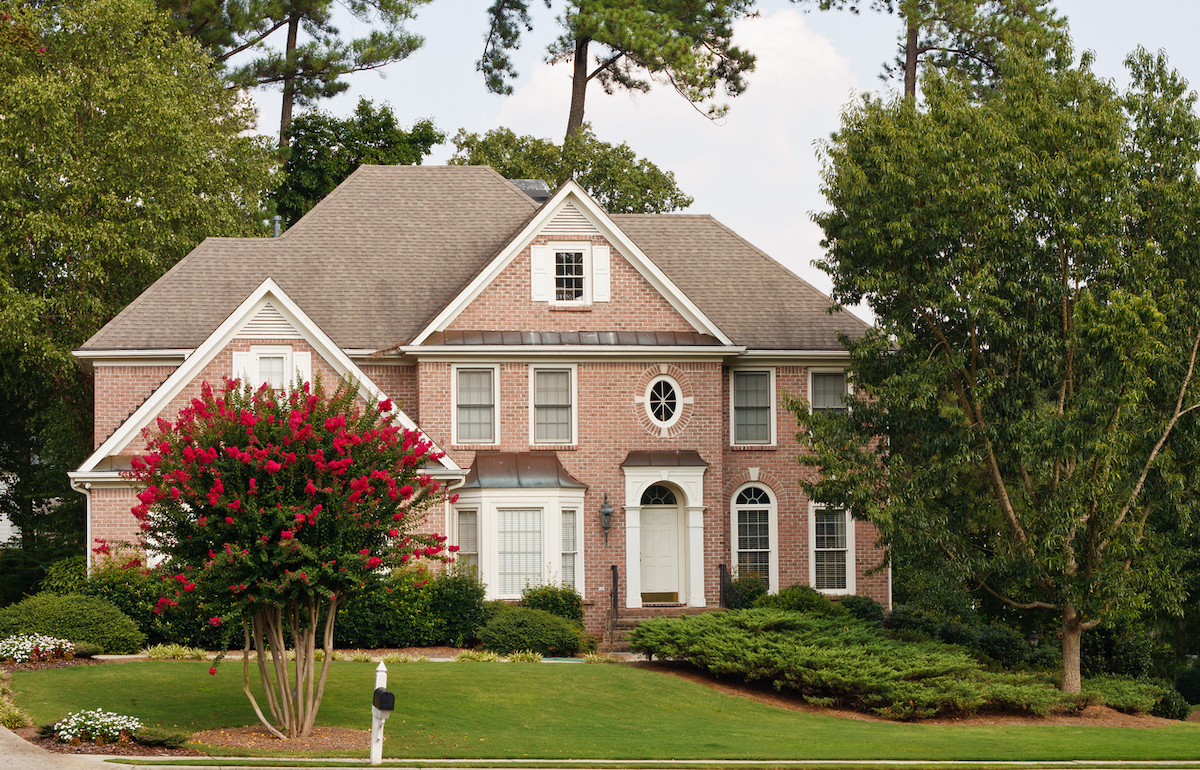

We may earn revenue from the products available on this page and participate in affiliate programs. Learn More ›
Though tall trees are lauded for providing shade and cooling the spaces around them, there’s plenty of good reason to plant some of their slighter-statured cousins on your property: Dwarf ornamental trees have plenty of visual impact and attract birds and pollinators to the area, while still offering some shade. Dwarf trees typically reach a maximum height of 30 feet, whereas standard trees like oaks, pines, maples, and walnut trees can grow to 80 feet or more.
Before choosing a tree for your yard, it’s a good idea to confirm your USDA hardiness zone, and have a good idea of how much sunlight your yard receives per day.
Benefits of Small Trees

You don’t have to have a small yard to consider planting small trees. Dwarf or miniature trees provide numerous benefits, making them worthy of a place in your landscape—or even on your deck or porch. Some can be container-grown, adding versatility and mobility to their charms.
Small trees for the front yard:
- Fill in gaps in your landscape design
- Create a layered landscape, with eye-catching color and texture at a lower level to complement the treetops
- Improve your home’s value
- Attract pollinators
- Require less watering, pruning, and overall maintenance
- Add a focal point to your lawn
- Are often low-maintenance
Many popular small trees for landscaping have non-invasive roots, making them ideal for planting near houses, walkways, or other structures. Even so, they should still be placed at least 10 feet from the house.
Small ornamental trees can be easier than large trees to incorporate into outdoor living areas and existing landscapes. If they’re flowering trees, dwarf trees add point-of-interest texture; they can also enhance your home’s curb appeal and bring attention to your home’s architectural elements.
1. Jelly King Crab Apple (Malus “Jelly King”)

While many small trees are ornamental and simply add visual interest to your landscaping, others offer a bonus of edible fruit. Growing to a maximum of 13 feet, Jelly King crab apple trees are a relatively new introduction from New Zealand. They produce orange-pink fruits that, as their name implies, are perfect for making jelly. In springtime, the flowering tree displays stunning large white blossoms. They’re also a low-maintenance choice, requiring minimal pruning and full sun or partial shade.
2. Japanese Maple (Acer japonicum)
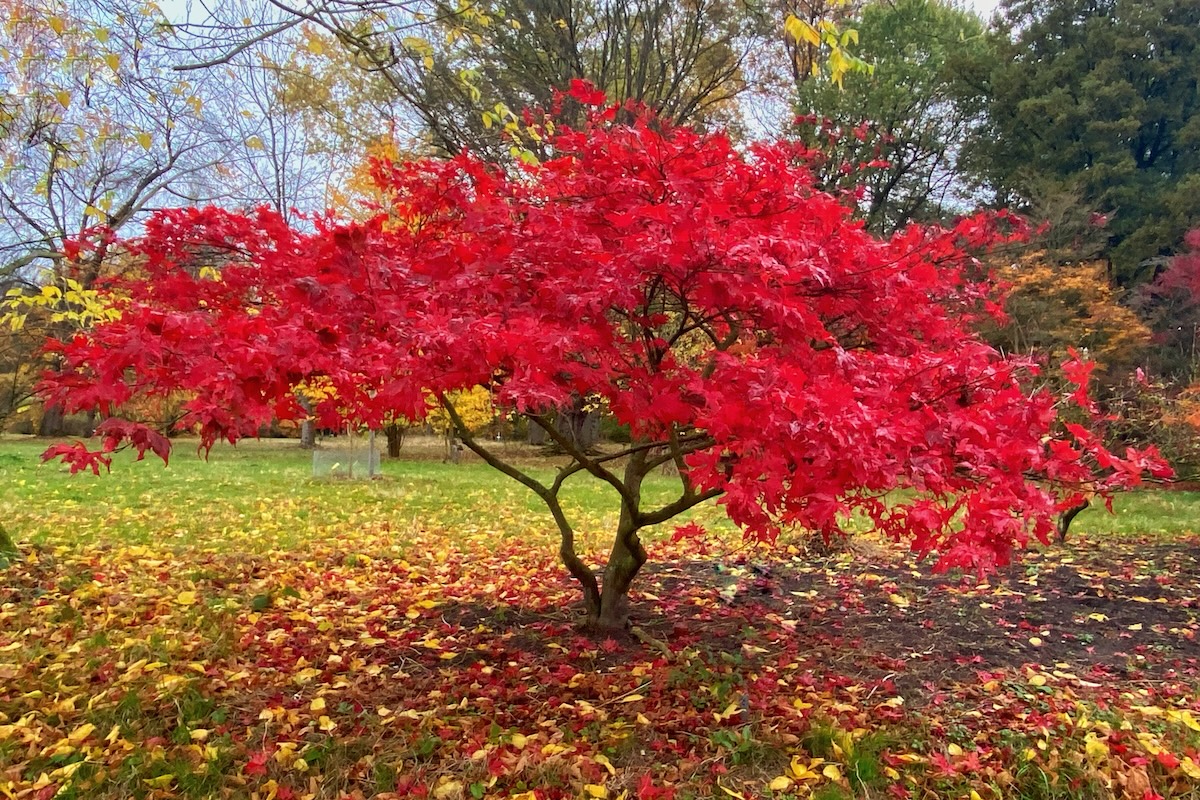
Japanese maples are popular because of their brightly colored leaves; it’s a tree for front-yard landscaping that is visually stunning over multiple seasons. There are many types of Japanese maples, which range in size from 8 to 30 feet. For a small space, look for a dwarf variety that will grow to only about 10 feet tall with a spread of 8 to 10 feet. Japanese maples thrive in zones 5 to 7 and most prefer partial shade.
3. Dwarf Chestnut Oak (Quercus prinoides)

The average oak tree is 65 feet tall, with chestnut oaks ranging in height from 59 to 72 feet. Dwarf chestnut oaks, however, grow to a maximum height of about 20 feet. They’re commonly found in eastern and central North America and do best in dry, rocky soil. They produce small acorns that taste sweet, so people and wildlife alike can enjoy them as a tasty treat.
4. Redbud (Cercis canadensis)
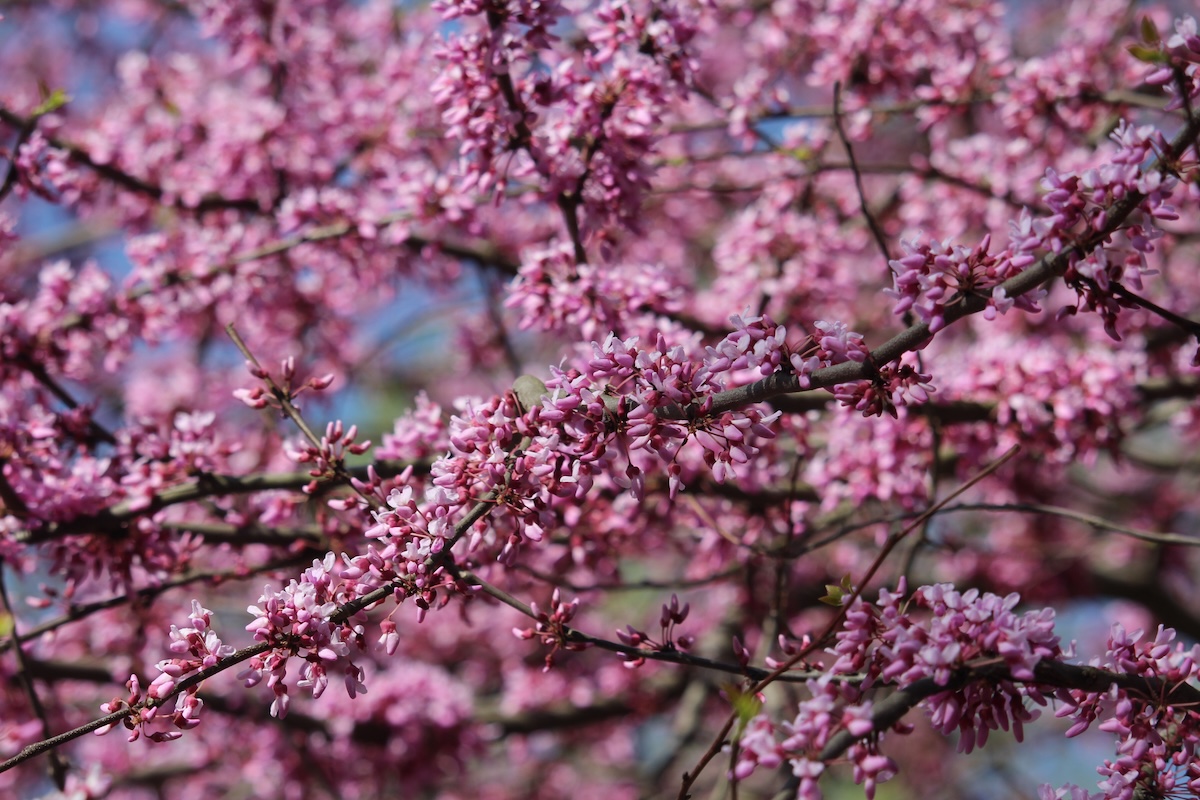
Redbud trees feature beautiful, heart-shaped leaves and flowers that come in an array of shades, depending on the variety. In springtime, the pink, white, or purple flowers will add a pop of color to your yard. Growing up to 10 feet high, the redbud does best in zones 5 through 9. Grow redbuds in full sun to part shade in well-drained soil with a moderate moisture level.
5. Hawthorn (Crataegus)
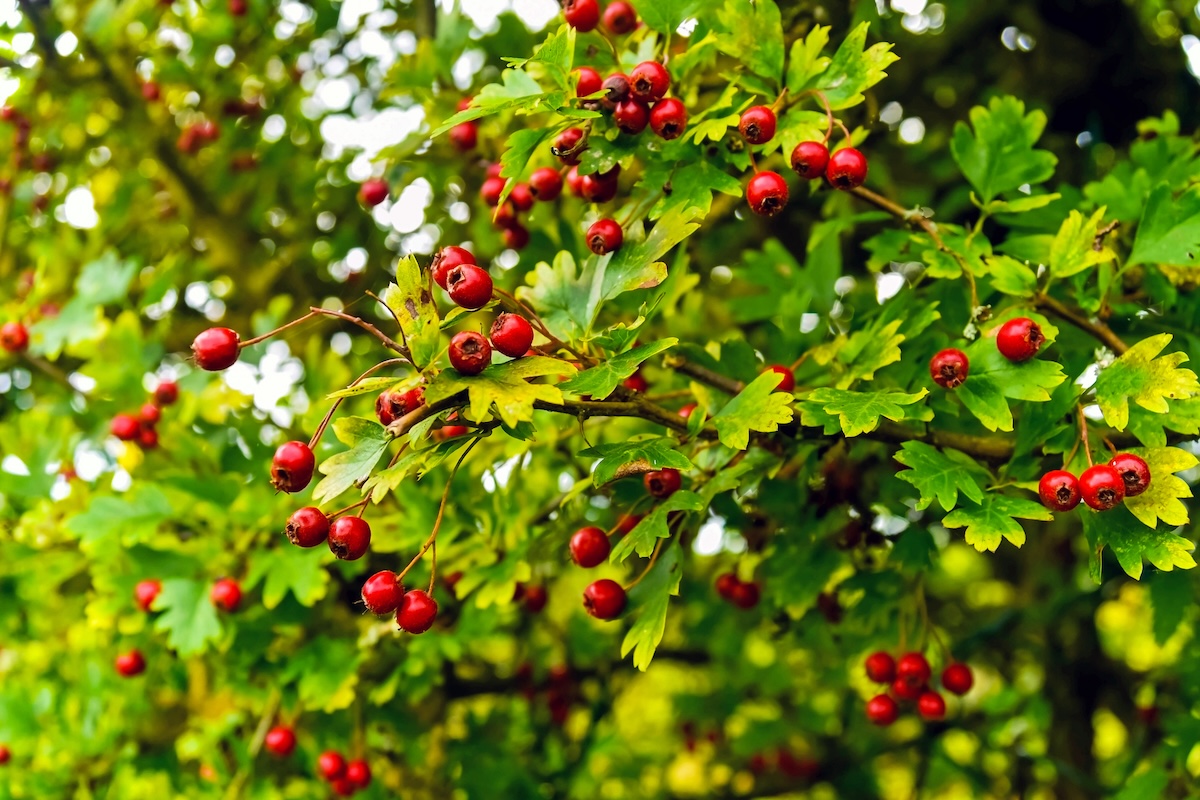
Hawthorn trees feature picture-perfect flowers in spring. In fall and winter, their red berries attract songbirds.
One of the few downsides to planting hawthorn is that it is prone to disease, including leaf blights and leaf spots. Spray hawthorns with neem oil in the spring to prevent infection. Some popular types of hawthorn trees include Crimson Cloud (C. laevigata) and Washington Hawthorn (C. phaenopyrum), the latter of which is more resistant to disease.
6. Saucer Magnolia (Magnolia soulangeana)
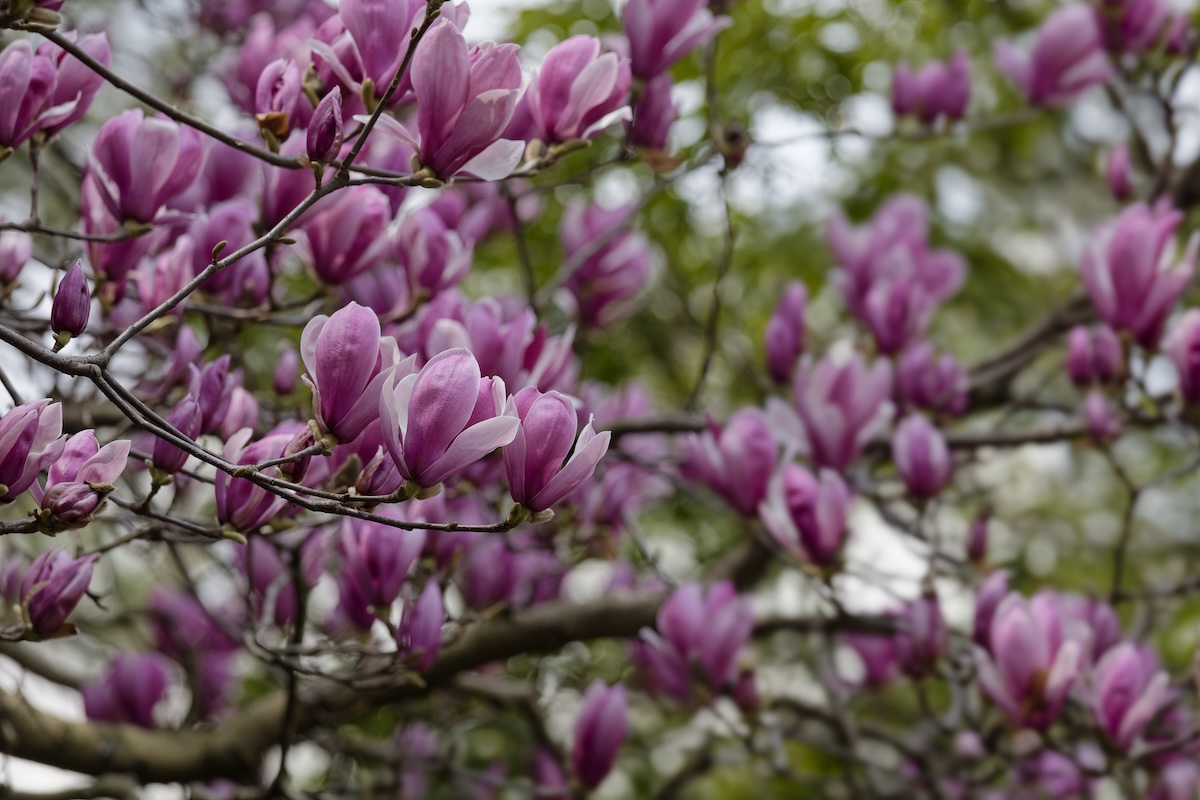
Made by cross-breeding lily magnolia and lily tree in the 1820s, saucer magnolia grows as either a shrub or small tree in both Europe and North America. In spring, this type of magnolia produces large, showy blooms with a pink-and-white hue. It does best in hardiness zones 4 through 9 and likes moist, well-drained soil. Avoid planting saucer magnolia on a southern exposure because this could cause it to bloom too early in the season.
7. Carolina Silverbell (Halesia carolina)
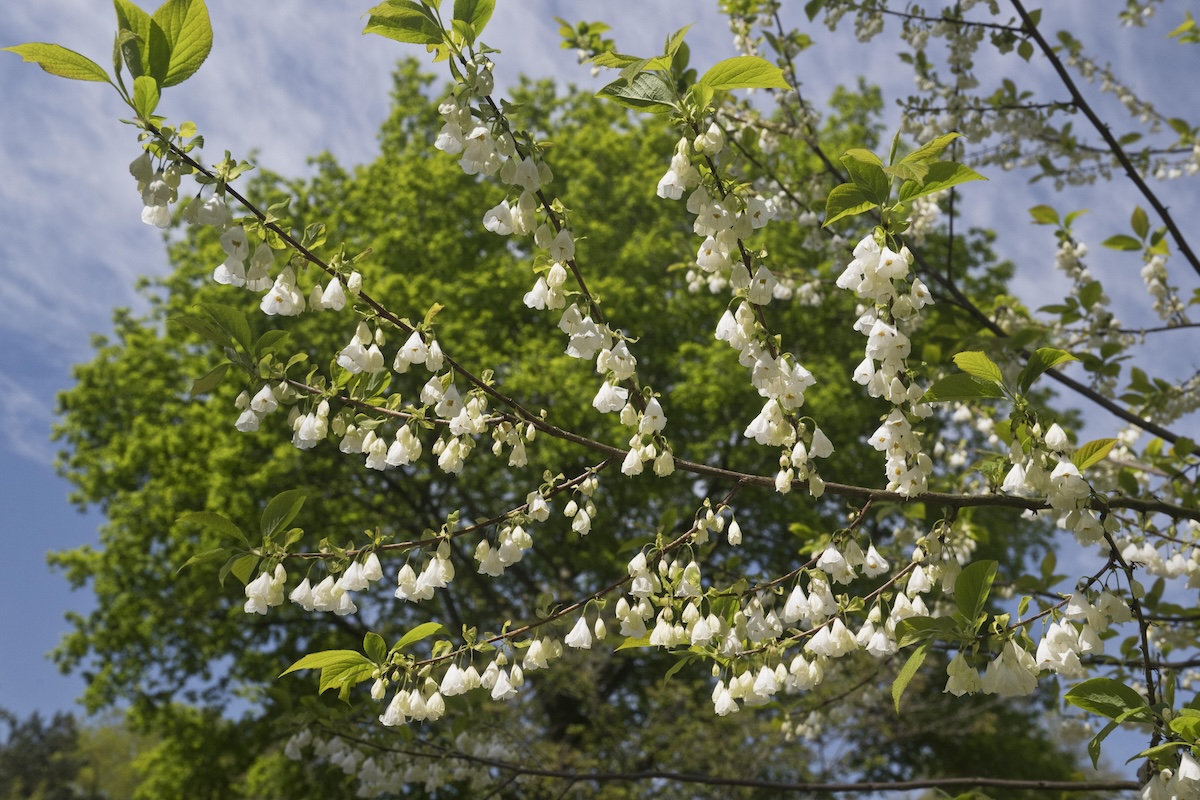
Native to the southeastern United States, Carolina Silverbells do best in hardiness zones 4 through 8. This tree is notable for its delicate blossoms, which attract bees, making it a great choice if you’re also growing dwarf fruit trees on your property. Maintain it as a shrub or prune it down to one central trunk to encourage it to grow as a tree. It reaches a maximum of 26 feet high and requires acidic soil, with a pH level of between 5 and 6.
8. Flowering Dogwood (Cornus florida)

This ornamental tree is native to North America, growing in zones 5 through 9, and produces pink or white flowers each spring. At summer’s end, flowering dogwood trees produce bright red fruit that birds love, so ornithophiles should consider this option for their yards. The dogwood matures at up to 30 feet high, and 10-year-old specimens typically have a height of around 15 feet.
9. Chaste Tree (Vitex agnus-castus)

Chaste trees bloom with lavender and violet flowers in the fall and grow to about 10 feet in height. Their fruit and leaves are both used in alternative medicine remedies to relieve menstrual cramps and balance hormones. One major advantage of chaste trees is that they’re drought tolerant, so these small trees are an ideal choice for desert climates in zones 6 through 9.
10. Japanese Snowbell (Styrax japonicus)

With their pretty white flowers and pleasant aroma, Japanese Snowbell trees are a great, low-maintenance choice for small lots. They look best in spring but maintain their leaves into the fall. Grow Japanese Snowbells in USDA zones 5 through 8a. In zones 7 and 8 they will appreciate partial shade, while they can handle full sun in zones 5 and 6.
11. Golden Chain Tree (Laburnum)

With showstopping yellow flowers that grow up to 20 inches long, Golden Chain trees are visually enchanting and produce a remarkable scent. They’re best grown by experienced gardeners because they can be somewhat fussy, require regular maintenance, and typically only flourish in hardiness zones 5 through 7. Since the seed pods are toxic, this tree is best for homes without small children or pets.
12. Wintersweet (Chimonanthus praecox)
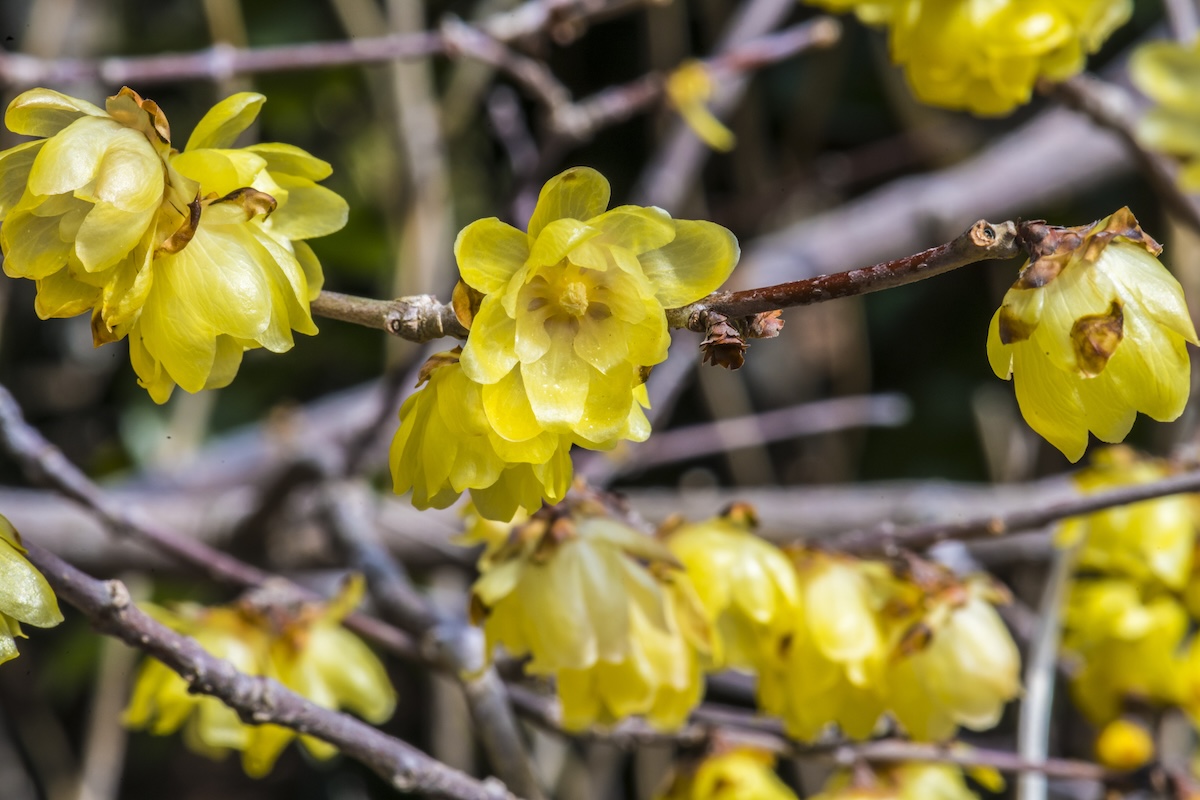
Those looking for a tree that provides color in the winter should consider this option, which thrives in zones 7 through 9. Wintersweet can be grown as a shrub or pruned to grow as a tree and has a maximum height of approximately 15 feet. The yellow blossoms produce an intoxicating smell, which is best appreciated in small spaces, making this tree an excellent choice for small yards.
13. Crape Myrtle (Lagerstroemia indica)

Known for its peeling gray-brown bark and clusters of crinkly, paper-like flowers of white, pink, red, violet, or purple, crape myrtle is one of the most popular small flowering trees, particularly in Southern gardens, where it blooms from summer through autumn, undaunted by heat and humidity. Drought-tolerant and easy to care for, the single- or multi-trunk myrtles prefer full sun in sheltered south- or west-facing spots in zones 6 and above (although some can survive in zone 5). Most grow just over 20 feet tall, with miniature versions reaching around 6 feet.
14. Serviceberry (Amelanchier alnifolia)

Considered large shrubs or single- or multi-stemmed small shade trees, serviceberry trees are often used as specimens, although they work well in a naturalized border against a backdrop of evergreens. Their year-round interest begins in spring with white, pink, or yellow blossoms that resemble apple blossoms and nourish pollinators, followed by blue-green foliage and edible red and purple berries favored by birds. They do best in partial to full sun and moist, well-drained soil in zones 2 through 8, where they grow to 6 to 25 feet tall.
15. Japanese Camelia (Camelia Japonica)

A Southern staple and the state flower of Alabama, Japanese camelia is a spring-flowering ornamental tree growing up to 12 feet tall. The slow-growing Asian beauty, with glossy, dark green, serrated leaves and single or double flowers in shades of white, pink, yellow, or red, grows best in sheltered locations with partial shade in zones 6 to 10. In northern zones, this tree can be grown as a container plant. Its requirement of well-draining, acidic soil makes it a fussy plant to maintain. Surface roots on these ornamental trees are noninvasive.
16. Royal Star Magnolia (Magnolia stellata)

This spring bloomer is a slow grower with a shallow, non-invasive root system. Reaching 15 to 20 feet tall, Royal Star magnolia is showstopper when in bloom, with large, fragrant pink, white, red, yellow, or lavender star-shaped flowers. It blooms earlier than saucer magnolias, on old wood. This specimen tree prefers full sun, but southern exposure can cause early blooming. A sheltered spot is best, to protect the large blossoms from late frosts. There’s no need to landscape around this tree; delicate petals will blanket the ground when it’s done blooming. Hardy in zones 4 through 10, this magnolia is a true compact, multi-stemmed star.
17. Banana Shrub (Michelia figo)

Named for the fragrance of its waxy, purple-edged, creamy yellow flowers rather than any relation to the banana, the banana shrub produces dense, glossy foliage on multiple stems, for a lush, tropical look. It does produce red follicular fruit if the flowers are pollinated. Grown in zones 8 to 10, it grows 6 to 10 feet tall, with a spread nearly as big. Easily pruned to maintain a height of 4 to 5 feet, this low-maintenance relative of the magnolia makes a nice privacy hedge in full sun to partial shade. Called the port wine magnolia or banana magnolia, it makes a good understory planting for large trees.
18. Royal Purple Smoke Tree (Cotinus boggygria)

The slow-growing smoke bush acquired its name from the long-lasting, airy plumes of billowy hairs on the flower clusters in late spring-early summer that, from a distance, give the appearance of smoke. Flowers turn from pink to purplish-pink, but once the flowers have faded, this upright, multi-stemmed tree continues to impress with its ovate-shaped magenta leaves. Grown in full sun in zones 4 to 9, smoke bush can reach 15 feet tall. Whether used as a specimen plant or grouped in a hedge, this easy-to-care-for, drought-tolerant native plant adds color and mystery to the landscape.
19. Fringe Tree (Chionanthus virginicus)

Clouds of feathery white flowers that perfume the garden in the evening with a sweet fragrance similar to lilacs are the fringe tree’s main attraction. This U.S. native plant is frequently planted as a specimen because of those sweet-smelling flowers set against gray bark. Before this deciduous tree drops its foliage for the winter, the female trees produce clusters of little blackish-blue edible drupe fruits. Growing up to 20 feet tall, fringe trees thrive in full sun or partial shade in wet river bottoms in zones 3 through 8. Shallow lateral roots are non-invasive.
20. Powder Puff (Calliandra haematocephala)

Technically a large, fast-growing shrub, this Bolivian native is grown worldwide due to the popularity of its puffy, fuzzy red or pink winter blooms that are a favorite of pollinators. A fast-growing dwarf evergreen, powder puff can grow to 6 feet tall, but can be pruned like a shrub or hedge; in fact, it needs pruning to manage its growth. It can also be grown in a container or trained on a trellis, where its mimosa-like leaves add to the airy effect of its soft, fuzzy flowers. Powder puff prefers full sun and does best in warm, humid regions in zones 9 through 11.
